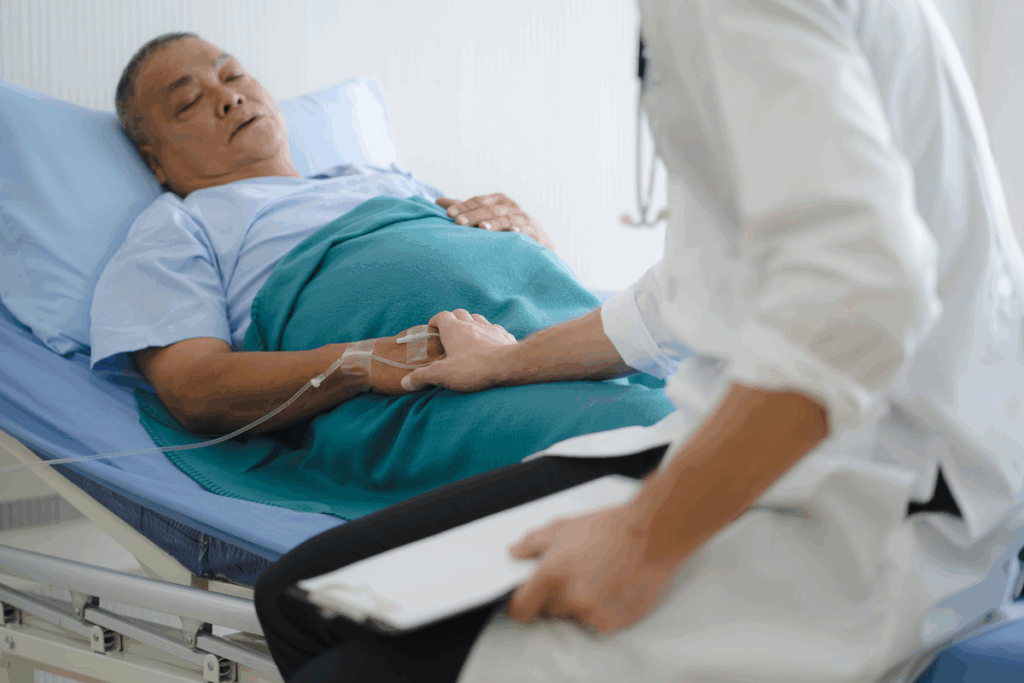Last Updated on October 30, 2025 by Bilal Hasdemir

Feeling persistent pain or fever in your upper abdomen is scary. It’s important to know why it’s happening. Gallbladder inflammation can be serious if it’s caused by gallstones blocking the cystic duct.Know these 8 critical cholecystitis symptoms. Learn the alarming signs, causes, and dangerous complications of gallbladder inflammation.
Liv Hospital is great at treating gallbladder infections. They use care that focuses on the patient and international standards. Knowing the symptoms of gallbladder infection is key. These include pain in the right upper abdomen, fever, nausea, and tenderness.

Cholecystitis is when the gallbladder gets inflamed. This can happen suddenly or slowly over time. The gallbladder is a small organ under the liver that helps with digestion.
The gallbladder stores bile, a fluid from the liver that helps break down fats. Bile goes into the small intestine to help digest fatty foods. The gallbladder has a cystic duct that connects it to the common bile duct, allowing bile to flow into the intestine.
Cholecystitis happens when the gallbladder gets inflamed, often because of gallstones blocking the cystic duct. This blockage causes bile to build up, making the gallbladder swell and get inflamed.
Cholecystitis can be acute or chronic. Acute cholecystitis starts suddenly, causing severe pain in the right upper abdomen, fever, and nausea. It needs quick medical help to avoid serious problems.
Chronic cholecystitis is a long-term issue where the gallbladder keeps getting inflamed, often because of gallstones. This can cause scarring and thickening of the gallbladder wall, making it less functional.
| Characteristics | Acute Cholecystitis | Chronic Cholecystitis |
| Onset | Sudden | Gradual or recurrent |
| Symptoms | Severe pain, fever, nausea | Mild or recurrent pain, possible jaundice |
| Duration | Short-term | Long-term |
| Gallbladder Condition | Distended, inflamed | Scarring, thickening of the wall |
Knowing the difference between acute and chronic cholecystitis is key for the right treatment. Acute cholecystitis needs quick medical help, while chronic cholecystitis might involve managing symptoms and finding the cause.

It’s important to know the signs of cholecystitis early. This condition, or inflammation of the gallbladder, shows different symptoms. These can be mild or very severe.
Severe pain in the right upper abdomen is a key symptom. This pain can stay the same or move to the right shoulder or back. People often feel tenderness in this area too.
Cholecystitis also brings fever, nausea, and vomiting. These signs show the body might be fighting an infection or inflammation.
Fever is the body’s way of fighting off infection. In cholecystitis, it means the gallbladder is infected. Nausea and vomiting can lead to dehydration if not treated.
The length of gallbladder pain varies. Sometimes, pain comes after eating or at night. Other times, it lasts for hours or days.
Knowing how long and what the pain feels like helps doctors diagnose and treat cholecystitis.
Gallstones are the main reason for gallbladder inflammation, also known as cholecystitis. These stones can block the cystic duct. This blockage causes the gallbladder to become inflamed.
Gallstones form in the gallbladder and are usually made of cholesterol or bilirubin. The exact way they form is complex. It involves an imbalance in bile, a fluid made by the liver and stored in the gallbladder.
The process starts when bile becomes too full of cholesterol or bilirubin. This causes these substances to solidify and form stones. Risk factors like obesity, diet, and certain medical conditions can make gallstones more likely.
The cystic duct connects the gallbladder to the common bile duct. It lets bile flow out of the gallbladder. If a gallstone gets stuck in this duct, it blocks the flow of bile.
This blockage causes bile to build up in the gallbladder. This leads to swelling and inflammation. The inflammation can be either short-term or long-term. If not treated quickly, it can cause serious problems.
Several factors can increase the chance of getting gallstones, including:
Knowing these risk factors can help prevent and catch gallstones early. This can lower the chance of getting cholecystitis.
It’s important to know how the gallbladder gets infected to treat cholecystitis well. The infection comes from bacteria getting into the gallbladder in different ways.
Primary bacterial invasion means bacteria directly infect the gallbladder. This can happen through the blood or bile ducts. Escherichia coli and Klebsiella species are often the culprits.
The bacteria can make the gallbladder inflamed. If not treated quickly, it can get worse.
Secondary infection happens when the cystic duct gets blocked, usually by gallstones. This blockage lets bile build up, which is perfect for bacteria to grow.
This is a big problem with gallstones and can cause acute cholecystitis. The bile acts as a breeding ground for bacteria, which then attack the gallbladder wall.
The usual culprits behind gallbladder infections are Escherichia coli, Klebsiella pneumoniae, and Enterococcus species. These bacteria live in the gut and can get to the gallbladder through different paths.
Knowing how gallbladder infections start helps doctors find the best treatments. This way, they can manage cholecystitis and avoid serious problems.
Gallstones are a main reason for gallbladder infection. But, other things can also cause it. Acalculous cholecystitis is a type of inflammation without gallstones.
Acalculous cholecystitis is serious and often affects very sick patients or those with big injuries. It’s a big part of acute cholecystitis in hospitals, mainly in ICU. The exact mechanisms are not fully understood, but stasis, ischemia, and infection play a role.
A medical expert said,
“Acalculous cholecystitis is a severe and potentially life-threatening condition that requires prompt diagnosis and treatment.”
Trauma and severe illness raise the risk of gallbladder infection. Major surgery, severe burns, or critical illness can cause acalculous cholecystitis. It has high morbidity and mortality rates, showing the need for early action.
Parasitic infestations and certain systemic diseases are rare causes. Sometimes, gallbladder inflammation shows a bigger problem, like vasculitis or a metabolic disorder.
The many possible causes highlight the need for a detailed diagnostic process for suspected gallbladder disease.
It’s important to know how irritation causes inflammation in the gallbladder. This helps us understand cholecystitis better. The gallbladder’s inflammation can start from different causes, like bile stasis and irritation.
Irritation in the gallbladder can start an inflammatory response. This happens when the gallbladder’s lining gets irritated, often by gallstones or bile stasis. This irritation brings in more inflammatory cells, causing swelling and pain.
“The inflammatory response is a defensive mechanism that aims to remove the irritant and initiate healing.” But if the irritation keeps going, the inflammation can turn chronic. This can lead to more serious problems.
Bile is key in gallbladder irritation. Bile stasis, or when bile doesn’t move, irritates the gallbladder lining. This can happen for many reasons, like gallstones blocking the cystic duct or the gallbladder not moving well.
The makeup of bile also matters. Abnormal bile composition can irritate the gallbladder lining, causing inflammation. Things like too much cholesterol or certain pigments can make bile abnormal.
Long-term irritation of the gallbladder can cause chronic inflammation, or chronic cholecystitis. This is when the gallbladder gets inflamed many times, causing scarring and thickening of the wall.
Chronic irritation can also make the gallbladder fibrotic, losing its function over time. “This loss of function can lead to persistent symptoms and may necessitate surgical intervention.” Knowing how chronic irritation affects the gallbladder is key to managing cholecystitis well.
Chronic cholecystitis is a condition where the gallbladder keeps getting inflamed. This inflammation can cause scarring and fibrosis, making the gallbladder less functional. It happens because the gallbladder gets inflamed many times, causing lasting damage.
When the gallbladder gets inflamed over and over, it scars. This scarring is the body’s way of trying to fix the damage. It leads to the growth of fibrotic tissue.
As time goes on, this tissue builds up. It makes the gallbladder less good at storing and releasing bile.
The scarring and fibrosis process goes through several stages:
Fibrotic tissue is a big part of chronic cholecystitis. As the gallbladder gets inflamed again and again, it gets more scarred. This scarring makes the gallbladder less able to work right, affecting digestion.
The table below shows the main differences between normal and fibrotic tissue:
| Characteristics | Normal Tissue | Fibrotic Tissue |
| Tissue Composition | Healthy mucosa and muscular layer | Too much collagen |
| Functionality | Good at storing and releasing bile | Not good at storing and releasing bile |
| Flexibility | Normal flexibility | Less flexible because of scarring |
The scarring and fibrosis from chronic cholecystitis really affect the gallbladder’s work. As it gets worse, the gallbladder can’t store and release bile as well. This can cause digestive problems.
People with chronic cholecystitis might have ongoing belly pain, nausea, and other digestive issues. This is because their gallbladder isn’t working right.
Inflammation in the gallbladder can spread to nearby tissues and organs. This can cause gallbladder colitis, where the gallbladder’s lining gets inflamed.
The gallbladder and liver are connected through the biliary system. Inflammation in the gallbladder can reach the liver, causing cholangitis. This can harm the liver’s detox and metabolism functions.
The gallbladder and liver are close, making it easy for inflammation to spread. This shows why treating gallbladder inflammation quickly is key to avoiding bigger problems.
Inflammation can spread to tissues and organs around the gallbladder. This can cause pericholecystic inflammation, where the gallbladder’s surrounding tissues get inflamed. In severe cases, abscesses or gallbladder perforation can occur.
The severity of the inflammation and how the body reacts to it can affect how far it spreads. Sometimes, it stays close to the gallbladder, but other times, it can spread widely, affecting many areas.
Cholecystitis can cause inflammation that affects the whole body. This can lead to symptoms like fever, fatigue, and feeling unwell. In severe cases, it can cause sepsis, a dangerous condition.
The systemic effects of gallbladder inflammation highlight the need for early diagnosis and treatment. Quick action can stop inflammation from spreading and reduce the risk of serious issues.
Several factors can raise your chance of getting cholecystitis. These include who you are, any health issues you might have, and your lifestyle. Knowing these can help prevent and manage gallbladder disease.
Some groups are more likely to get cholecystitis. These include:
Some health issues can up your risk of cholecystitis. These include:
| Medical Condition | Risk Level | Reason |
| Diabetes | High | Increased risk of gallstone formation |
| High Cholesterol | High | Cholesterol crystallization in bile |
| Obesity | Moderate to High | Increased cholesterol in bile |
What you do every day can also affect your risk. These include:
Knowing these risk factors can help you take steps to lower your chance of getting cholecystitis. This includes eating well, staying active, and managing health conditions.
Untreated cholecystitis can lead to severe and potentially life-threatening complications. It is vital to understand these risks to see why quick medical help is so important.
One serious complication is gallbladder perforation. This happens when inflammation weakens the gallbladder wall, causing it to rupture. This releases bile and infected material into the abdominal cavity. Gallbladder perforation can cause peritonitis, a severe inflammation of the peritoneum.
Another complication is the formation of an abscess within or around the gallbladder. An abscess is a collection of pus that can develop from the infection. If not drained, an abscess can rupture, leading to further infection and potentially life-threatening consequences.
Untreated cholecystitis can also lead to sepsis, a systemic infection that occurs when bacteria enter the bloodstream. Sepsis is a serious condition that can cause widespread inflammation and organ dysfunction. It requires immediate medical attention.
In severe cases, the inflammation associated with cholecystitis can cause gangrene of the gallbladder, leading to tissue death. Gangrene can result in the perforation of the gallbladder and the spread of infection to other parts of the body.
The following table summarizes the possible complications of untreated cholecystitis:
| Complication | Description | Potential Outcome |
| Gallbladder Perforation | Rupture of the gallbladder wall | Peritonitis, severe abdominal infection |
| Abscess Formation | Collection of pus around the gallbladder | Rupture of abscess, further infection |
| Sepsis and Systemic Infection | Bacteria entering the bloodstream | Systemic inflammation, organ dysfunction |
| Gangrene and Tissue Death | Tissue death due to lack of blood supply | Gallbladder perforation, spread of infection |
Understanding these possible complications shows why it’s important to seek medical attention if symptoms of cholecystitis occur. Quick treatment can prevent these serious outcomes and improve patient outcomes.
Diagnosing cholecystitis involves several steps. It includes a clinical check-up, lab tests, and imaging. This thorough process helps confirm cholecystitis and rule out other conditions with similar symptoms.
A physical exam is key in diagnosing cholecystitis. People with cholecystitis often have tenderness in the right upper abdomen. They might also have a stiff abdominal wall.
The Murphy’s sign is a special test. It checks for pain when a patient inhales deeply with pressure on the right upper abdomen.
Labs are important in diagnosing cholecystitis. They show signs of inflammation or infection, like an elevated white blood cell count. Liver function tests can also be abnormal.
Imaging studies help see the gallbladder. Ultrasonography is often the first choice. It’s good at finding gallstones and inflammation signs.
Other tests, like computed tomography (CT) scans or magnetic resonance cholangiopancreatography (MRCP), might be used too. They help check the gallbladder and biliary ducts or spot complications.
When checking for cholecystitis, other possible causes must be considered. These include biliary colic, choledocholithiasis, or other stomach issues. A detailed diagnostic process helps pinpoint cholecystitis and plan the right treatment.
Understanding cholecystitis is key to managing it well. Knowing the signs of gallbladder inflammation helps people get help fast. This can lower the chance of serious problems.
Keeping a healthy lifestyle is important to prevent gallbladder issues. Eating right and exercising often is essential. Being at a healthy weight is also critical, as being overweight increases the risk of gallstones.
To lower gallbladder disease risk, avoid fatty foods and eat more fiber. Drinking plenty of water is also good. Regular health check-ups can catch problems early, helping manage gallbladder health better.
Knowing about cholecystitis and taking care of your gallbladder can help avoid this condition. This approach can improve your life quality by reducing risks and complications.
Cholecystitis is when the gallbladder gets inflamed. This can happen suddenly or over time. It often starts when a gallstone blocks the cystic duct, causing infection and inflammation.
Symptoms include pain in the right upper abdomen, fever, nausea, and vomiting. The pain and symptoms can vary in how bad they are and how long they last.
The gallbladder can get infected in two ways. It can be directly infected by bacteria or it can get infected after being blocked by a gallstone. Bacteria like E. coli and Klebsiella are common culprits.
Acalculous cholecystitis is inflammation of the gallbladder without gallstones. It can be caused by trauma, illness, or other factors that affect the gallbladder’s function.
Yes, pain from the gallbladder can last for days or even weeks. This depends on the cause and how severe the inflammation is.
If left untreated, cholecystitis can lead to serious problems. These include perforation of the gallbladder, abscesses, sepsis, and gangrene.
Doctors use physical exams, lab tests, and imaging like ultrasound or CT scans to diagnose cholecystitis. They also rule out other conditions to make an accurate diagnosis.
Certain factors increase the risk of getting cholecystitis. These include being female, having diabetes, being obese, and eating a diet high in fat.
Chronic cholecystitis can cause scarring and fibrosis in the gallbladder. This can impair its function and lead to long-term digestive problems.
The gallbladder and liver are connected through the biliary system. Inflammation in the gallbladder can spread to the liver and other areas, causing more widespread inflammation.
Yes, making healthy lifestyle choices can help prevent gallbladder inflammation. This includes maintaining a healthy weight, eating a balanced diet, and avoiding fatty foods.
Shogan, B. D., et al. (2024). The American Society of Colon and Rectal Surgeons Clinical Practice Guidelines for the treatment of colorectal diseases: Minimally invasive colorectal surgery. Diseases of the Colon & Rectum. https://pmc.ncbi.nlm.nih.gov/articles/PMC11640238/
Subscribe to our e-newsletter to stay informed about the latest innovations in the world of health and exclusive offers!
WhatsApp us